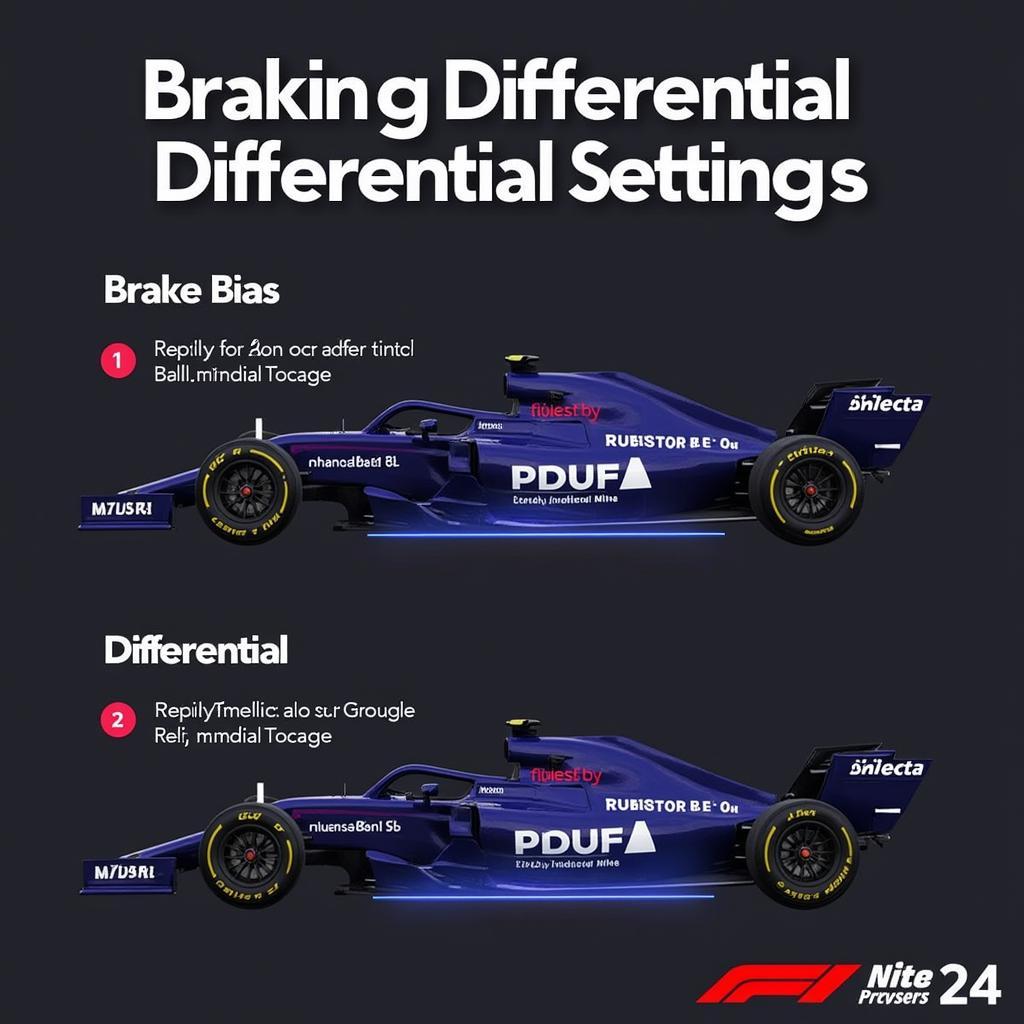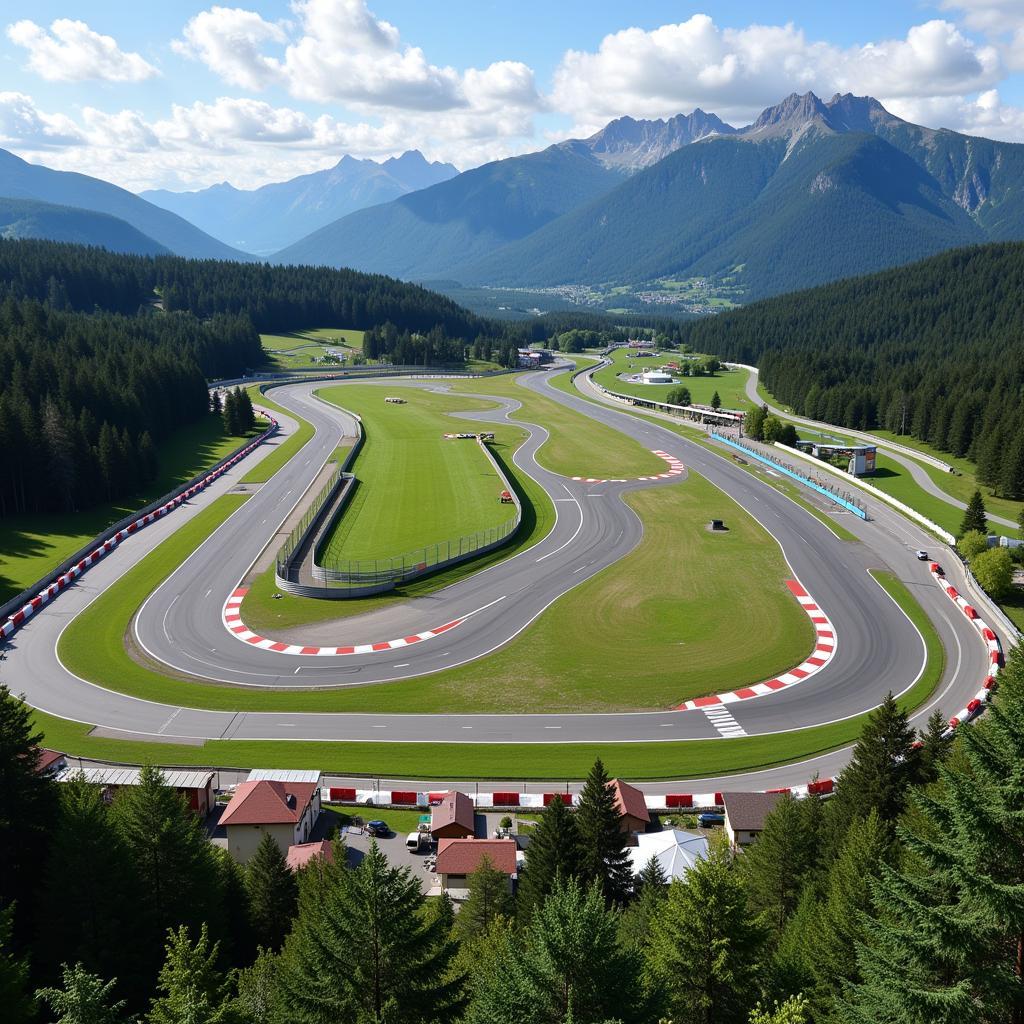Conquering the Red Bull Ring in F1 24 requires more than just raw speed; it demands a finely tuned Austria F124 Setup. This guide delves into the intricacies of creating the perfect setup for the Austrian Grand Prix, covering everything from aerodynamics and suspension to brake bias and differential settings. Whether you’re a seasoned veteran or a newcomer to the track, this guide will equip you with the knowledge to dominate the Spielberg circuit.
The Austrian track, with its long straights and challenging corners, presents a unique setup challenge. Finding the optimal balance between straight-line speed and downforce is key to a competitive lap time. Let’s explore the essential elements of a winning austria f124 setup.
Aerodynamics: Balancing Speed and Grip
Aerodynamics play a crucial role at the Red Bull Ring. The long straights necessitate a lower downforce configuration to maximize top speed. However, corners like Turn 3 and Turn 4 require sufficient grip for stable braking and cornering. Finding this balance is the first step to a strong austria f124 setup. Aim for a front wing setting slightly lower than the default, while the rear wing can be adjusted based on your driving style and comfort level. A lower rear wing will increase top speed but reduce stability in high-speed corners.
Suspension: Finding the Sweet Spot
Suspension setup is critical for maintaining tire contact and maximizing mechanical grip. For the Austrian track, a slightly softer suspension setup can be beneficial. This allows the car to absorb the bumps and kerbs, improving stability and traction. However, avoid going too soft, as it can lead to excessive body roll and unpredictable handling. Start with a slightly softer front suspension setting than the rear to improve turn-in. Fine-tune the ride height based on your preference, keeping in mind that a lower ride height improves downforce but can make the car more susceptible to bottoming out.
Brakes and Differential: Fine-tuning for Control
Brake bias and differential settings are crucial for controlling the car under braking and acceleration. For Austria, a slightly forward brake bias can help improve braking stability into the heavy braking zones like Turn 3. The differential settings should be adjusted to optimize traction out of slow corners, allowing you to maximize acceleration down the long straights. A more open differential on throttle will help rotate the car on corner exit, while a locked differential will provide more stability.
 F1 24 Austria Brake and Differential Setup
F1 24 Austria Brake and Differential Setup
Tires: Managing Degradation for Optimal Performance
Tire management is a significant factor in F1 24, and Austria is no exception. The high-speed nature of the track puts a lot of stress on the tires, especially the rears. Maintaining consistent tire pressures and temperatures is essential for maximizing their lifespan and performance. Monitor your tire temperatures closely throughout practice and the race and adjust your driving style accordingly.
Putting it all Together: A Sample Austria F1 24 Setup
While the ideal setup will vary based on your driving style and car, here’s a sample austria f124 setup to get you started:
- Aerodynamics: Front Wing: 5, Rear Wing: 7
- Suspension: Front Suspension Stiffness: 6, Rear Suspension Stiffness: 8
- Brakes: Brake Bias: 57%
- Differential: On Throttle: 50%, Off Throttle: 70%
“The Austrian track demands a delicate balance. Too much downforce, and you’ll be a sitting duck on the straights. Too little, and you’ll struggle in the corners. Finding that sweet spot is the key to success,” says Alex Rossi, a former Formula 1 driver.
Conclusion: Dominating the Red Bull Ring
Mastering the austria f124 setup is the key to unlocking your full potential at the Austrian Grand Prix. By understanding the nuances of the track and implementing the strategies outlined in this guide, you’ll be well on your way to conquering the Red Bull Ring. Experiment, adapt, and refine your setup to find what works best for you. f1 24 austria setup
 F1 24 Austria Track Overview
F1 24 Austria Track Overview
“Remember, a good setup is just the starting point. Consistent driving and strategic tire management are equally important for a successful race,” adds Maria Vanderlinden, a renowned F1 engineer.
FAQ
- What is the most important aspect of the Austria F1 24 setup?
Finding the right balance between downforce and straight-line speed. - Should I run a softer or stiffer suspension setup in Austria?
A slightly softer suspension is generally recommended. - How does brake bias affect performance at the Red Bull Ring?
A slightly forward brake bias can improve braking stability. - What are the key corners to focus on when setting up the car for Austria?
Turns 3 and 4 are crucial for finding the right balance. - How important is tire management at the Austrian Grand Prix?
Tire management is critical due to the high-speed nature of the track. - Where can I find a good starting point for my Austria F1 24 setup?
This guide provides a sample setup, but you should adjust it to your driving style. - What other factors contribute to a successful race in Austria besides the setup?
Consistent driving and strategic tire management are equally important.
Need support? Contact us 24/7: Phone: 0902476650, Email: [email protected], Address: 139 Đ. Võ Văn Kiệt, Hoà Long, Bà Rịa, Bà Rịa – Vũng Tàu, Việt Nam. Check out our other articles on F1 24 setups and strategies.





